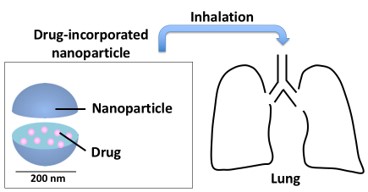Example
Developing a therapeutic method for pulmonary hypertension by a Drug Delivery System using drug-incorporated nanoparticles
Social background
Medical treatment for pulmonary hypertension has developed significantly over the past decade; however, since there are recalcitrant cases, further development of therapeutic methods is expected. Furthermore, regarding the epoprostenol (PGI2) continuous infusion method, which is currently the most effective therapeutic method, there remain some issues, including the medication method.
A nanoparticle generally refers to a particle approximately 100 nm in size, and in medicine, the application of drug-incorporated nanoparticles is advanced as a Drug Delivery System (DDS). After nanoparticles are introduced to the internal organ, they are broken down and the incorporated drug is released to exert an effect. This makes it possible to transport the administered drug specifically to the target internal organ and thereby exert an effect of the drug specifically on the target internal organ and at the same time reduce adverse effects.
Objectives of activities
We aim to develop a therapeutic method for pulmonary hypertension by a Drug Delivery System using drug-incorporated nanoparticles.
Overview of activities
We compiled several reports on basic research on DDS using drug-incorporated nanoparticles in pulmonary hypertension (J Clin Med 2017 and Int J Mol Sci 2019). When poly (lactide-co-glycolic acid) (PLGA), which is hydrolyzed into water and CO2 within an organism, is nanoparticulated, and nanoparticles encapsulating imatinib (Int Heart J 2015) and beraprost, which is a PGI2 derivative (J Cardiovasc Pharmacol 2016), are intratracheally instilled in an animal model, the right ventricular systolic pressure dropped, right ventricular hypertrophy was reduced, the pulmonary artery media thickness was reduced, and life prognosis was improved. In other words, the condition of pulmonary hypertension was improved.
We plan to develop more drugs and apply them in a clinical setting.
Expected effects
It is expected that inhalation therapy by drug-incorporated nanoparticles will be a new therapeutic method for pulmonary hypertension and right cardiac failure.

URL
http://okayama-u-cvm.jp/intern/about.html
Representative
